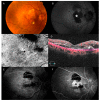Matrix Metalloproteinases in Age-Related Macular Degeneration (AMD)
- PMID: 32824762
- PMCID: PMC7460693
- DOI: 10.3390/ijms21165934
Matrix Metalloproteinases in Age-Related Macular Degeneration (AMD)
Abstract
Age-related macular degeneration (AMD) is a complex, multifactorial and progressive retinal disease affecting millions of people worldwide. In developed countries, it is the leading cause of vision loss and legal blindness among the elderly. Although the pathogenesis of AMD is still barely understood, recent studies have reported that disorders in the regulation of the extracellular matrix (ECM) play an important role in its etiopathogenesis. The dynamic metabolism of the ECM is closely regulated by matrix metalloproteinases (MMPs) and the tissue inhibitors of metalloproteinases (TIMPs). The present review focuses on the crucial processes that occur at the level of the Bruch's membrane, with special emphasis on MMPs, TIMPs, and the polymorphisms associated with increased susceptibility to AMD development. A systematic literature search was performed, covering the years 1990-2020, using the following keywords: AMD, extracellular matrix, Bruch's membrane, MMPs, TIMPs, and MMPs polymorphisms in AMD. In both early and advanced AMD, the pathological dynamic changes of ECM structural components are caused by the dysfunction of specific regulators and by the influence of other regulatory systems connected with both genetic and environmental factors. Better insight into the pathological role of MMP/TIMP complexes may lead to the development of new strategies for AMD treatment and prevention.
Keywords: Bruch’s membrane; MMPs polymorphisms; age-related macular degeneration; extracellular matrix; matrix metalloproteinases; tissue inhibitors of metalloproteinases.
Conflict of interest statement
The authors declare no conflict of interest.
Figures



References
-
- Korb A., Kottler U.B., Wolfram C., Höhn R., Schulz A., Zwiener I., Wild P.S., Pfeiffer N., Mirshahi A. Prevalence of age-related macular degeneration in a large European cohort: Results from the population-based Gutenberg Health Study. Graefe’s Arch. Clin. Exp. Ophthalmol. 2014;252:1403–1411. doi: 10.1007/s00417-014-2591-9. - DOI - PubMed
-
- Wong W.L., Su X., Li X., Cheung C.M.G., Klein R., Cheng C.Y., Wong T.Y. Global prevalence of age-related macular degeneration and disease burden projection for 2020 and 2040: A systematic review and meta-analysis. Lancet Glob. Health. 2014;2:e106–e116. doi: 10.1016/S2214-109X(13)70145-1. - DOI - PubMed
Publication types
MeSH terms
Substances
LinkOut - more resources
Full Text Sources
Medical
Research Materials
Miscellaneous

